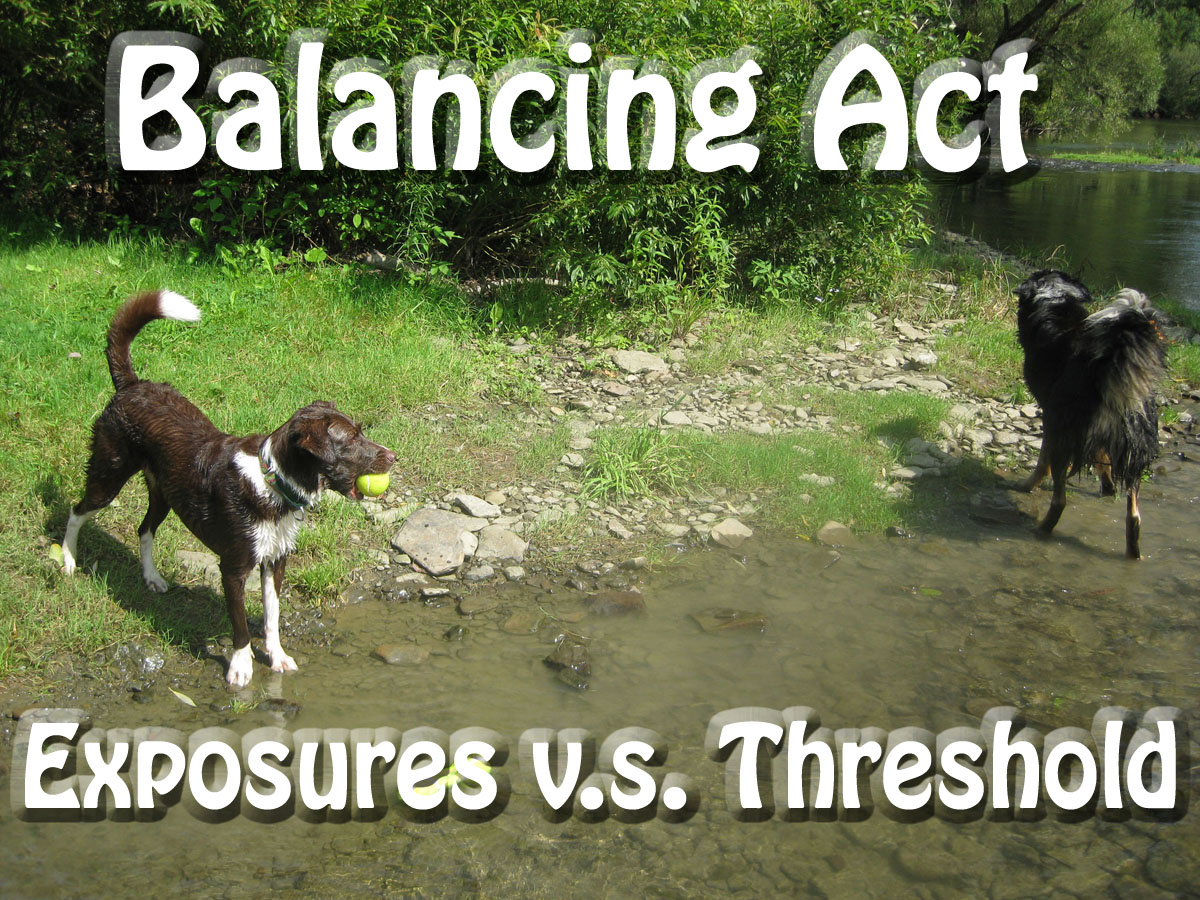When working with a project dog (reactive, fearful, aggressive, etc) it is generally a process of slowly changing the threshold and the reaction to the stimulus. In doing this, there is this very strange push and pull effect going on…we are pushing boundaries through exposure while also pulling back to keep the dogs under threshold. Doing one with out the other would be, in my opinion, a really detrimental process. There really is a balancing act that must be performed for positive change to happen–and while the process is similar between dogs, each dog is an individual.
Completely avoiding the object/environment/situation that causes a dog distress is not helpful long term. It will prevent any reactions/fear responses, but it will not effect the overall problem. I’m scared of heights–well technically, I’m scared of falling from heights–I don’t do high dives or jumping off tall objects into bodies of water. I haven’t since I was about 9 when I bravely tried to face my fear–I jumped from a high dive twice and was no less scared. Avoiding heights as best I can has not addressed my concerns. I am still uncomfortable if I have to walk across a seemingly unstable bridge (though perfectly safe), for example, and there are even some select escalators that make me woozy and white-knuckle-grip the railings. While I think managing situations and preventing exposure is a part of the solution, it is not the solution in its entirety. *There are some things where management is the easiest solution–like counter surfing and garbage diving, but these are more problem behaviors and less behavioral problems.
On the flip side of things, telling a dog to “get over it” by forcing prolonged exposures while over threshold is unacceptable. Facing one’s fears does not necessarily mean all at once–I would not get over my fear of heights by being forced to walk over a suspension bridge 100ft above jagged rocks. I have, however, taken to riding roller coasters as a way to build up confidence on tall/fast/seemingly dangerous objects. After some apprehension and fear, I now enjoy roller coasters. With the roller coasters, it was not a matter of being forced to ride the biggest, baddest coaster around. I made the choice to ride a steel coaster that was almost entirely loop-de-loops. It was not terribly tall or terribly fast but it was the first exposure to something I once feared greatly and was also building my confidence with heights. Some humans may choose to get over their fears by diving into them, but there is a huge difference between making a choice and being forced to face one’s fears by taking the brunt head on.
Dogs do not have the opportunity to make a choice to take on their fears by diving into them. So, for them they are being forced to confront their fears by someone else. Imagine your worst fear–I mean absolutely worst fear. For me it is honestly a toss up between heights and spiders. If someone had dragged me in line for a huge coaster, forced me into the seat and made me ride, I can guarantee you that I would never ride another coaster again. The anxiety that would have built up while being restrained in line, restrained on the platform, and forced into the seat and strapped in would have probably sent me to the hospital with a huge panic attack. There is no way that being forced to face my fears like that would have any positive outcomes for me. However, when I made the choice to face my fears, my anxiety level was high while in line but not out of control–I knew that I could bail out without anything but a few disappointing looks from my friends. Dogs are never really able to make the choice, we are almost always in the position of forcing them to change their feelings about various stimuli (kids, cars, dogs, cats, men, etc) and, because they are not making a choice to face their fears head on, we, as handlers, must acknowledge that the dogs are in a vulnerable position and go about things differently.
One of the things I think we need to change is how we think of the whole process. It is not a matter of making our dogs confront their fears–we are, instead simply changing how the dogs feel about the stimuli and teaching them how to react in a more human-world appropriate manner.
Each time I work on changing a behavior with one of my dogs, I am pushing them to face their fears but also pulling back by keeping them just at/under their threshold. It really is a balancing act of pushing and pulling in the correct amount for that dog to have the best chance of success.
(412) 849-7788
successjustclicks@gmail.com


Outstanding entry!
Elli’s not particularly afraid of most things, but she does get overexcited when presented with certain stimuli. I think that this would also fit into the category of this balancing act you talk about. It’s something I have to work really hard on with her.